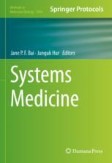Search
Search Results
-
A varying-coefficient regression approach to modeling the effects of wind speed on the dispersion of pollutants
The real-world monitoring system of air pollution ordinarily collects data about pollutant concentration levels at pollution sources and monitors...

-
Obtaining Longevity Footprints in DNA Methylation Data Using Different Machine Learning Approaches
AgingAging as an irreversible process is characterized by a progressive decline in many body functions and increased vulnerability to various...
-
Predicting lncRNA-disease associations using multiple metapaths in hierarchical graph attention networks
BackgroundMany biological studies have shown that lncRNAs regulate the expression of epigenetically related genes. The study of lncRNAs has helped to...

-
Nonnegative spatial factorization applied to spatial genomics
Nonnegative matrix factorization (NMF) is widely used to analyze high-dimensional count data because, in contrast to real-valued alternatives such as...

-

-
MAVE-NN: learning genotype-phenotype maps from multiplex assays of variant effect
Multiplex assays of variant effect (MAVEs) are a family of methods that includes deep mutational scanning experiments on proteins and massively...

-
MarkerMap: nonlinear marker selection for single-cell studies
Single-cell RNA-seq data allow the quantification of cell type differences across a growing set of biological contexts. However, pinpointing a small...

-
Scanorama: integrating large and diverse single-cell transcriptomic datasets
Merging diverse single-cell RNA sequencing (scRNA-seq) data from numerous experiments, laboratories and technologies can uncover important biological...

-
Approximate inference of gene regulatory network models from RNA-Seq time series data
BackgroundInference of gene regulatory network structures from RNA-Seq data is challenging due to the nature of the data, as measurements take the...

-
Normalization and de-noising of single-cell Hi-C data with BandNorm and scVI-3D
Single-cell high-throughput chromatin conformation capture methodologies (scHi-C) enable profiling of long-range genomic interactions. However, data...

-
Statistical analysis of organelle movement using state-space models
BackgroundOrganelle motility is essential for the correct cellular function of various eukaryotic cells. In plant cells, chloroplasts move towards...

-
scAbsolute: measuring single-cell ploidy and replication status
Cancer cells often exhibit DNA copy number aberrations and can vary widely in their ploidy. Correct estimation of the ploidy of single-cell genomes...

-
Differences in visually induced MEG oscillations reflect differences in deep cortical layer activity
Neural activity is organized at multiple scales, ranging from the cellular to the whole brain level. Connecting neural dynamics at different scales...

-
Label-aware distance mitigates temporal and spatial variability for clustering and visualization of single-cell gene expression data
Clustering and visualization are essential parts of single-cell gene expression data analysis. The Euclidean distance used in most distance-based...

-
scDALI: modeling allelic heterogeneity in single cells reveals context-specific genetic regulation
While it is established that the functional impact of genetic variation can vary across cell types and states, capturing this diversity remains...

-
Introduction to Genomic Network Reconstruction for Cancer Research
High-throughput genomic technologies have revolutionized the study of cancer. Current research in oncology is now limited more for the capacity of...
-
Learning protein fitness models from evolutionary and assay-labeled data
Machine learning-based models of protein fitness typically learn from either unlabeled, evolutionarily related sequences or variant sequences with...

-
Modelling human behaviour in cognitive tasks with latent dynamical systems
Response time data collected from cognitive tasks are a cornerstone of psychology and neuroscience research, yet existing models of these data either...

-
Deep Learning Methods for Single-Cell Omics Data
Deep learning has become an appealing computational tool for analyzing single-cell omics data. We review statistical and modeling insights that have...
-
BRIE2: computational identification of splicing phenotypes from single-cell transcriptomic experiments
RNA splicing is an important driver of heterogeneity in single cells through the expression of alternative transcripts and as a determinant of...

